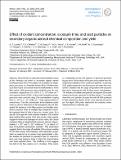| dc.contributor.author | Lambe, A. T. | |
| dc.contributor.author | Chhabra, P. S. | |
| dc.contributor.author | Onasch, T. B. | |
| dc.contributor.author | Brune, W. H. | |
| dc.contributor.author | Cummings, M. J. | |
| dc.contributor.author | Brogan, J. F. | |
| dc.contributor.author | Parmar, Y. | |
| dc.contributor.author | Worsnop, D. R. | |
| dc.contributor.author | Kolb, C. E. | |
| dc.contributor.author | Davidovits, P. | |
| dc.contributor.author | Hunter, James Freeman | |
| dc.contributor.author | Kroll, Jesse | |
| dc.date.accessioned | 2017-07-05T13:46:06Z | |
| dc.date.available | 2017-07-05T13:46:06Z | |
| dc.date.issued | 2015-03 | |
| dc.date.submitted | 2015-02 | |
| dc.identifier.issn | 1680-7375 | |
| dc.identifier.issn | 1680-7367 | |
| dc.identifier.uri | http://hdl.handle.net/1721.1/110441 | |
| dc.description.abstract | We performed a systematic intercomparison study of the chemistry and yields of secondary organic aerosol (SOA) generated from OH oxidation of a common set of gasphase precursors in a Potential Aerosol Mass (PAM) continuous flow reactor and several environmental chambers. In the
flow reactor, SOA precursors were oxidized using OH concentrations
ranging from 2.0 × 10[superscript 8] to 2.2 × 10[superscript 10] molec cm[superscript −3] over exposure times of 100 s. In the environmental chambers, precursors were oxidized using OH concentrations ranging
from 2 × 10[superscript 6] to 2 × 10[superscript 7] molec cm[superscript −3] over exposure times of several hours. The OH concentration in the chamber experiments is close to that found in the atmosphere, but the integrated
OH exposure in the flow reactor can simulate atmospheric exposure times of multiple days compared to chamber exposure times of only a day or so. In most cases, for a specific SOA type the most-oxidized chamber SOA and the least-oxidized flow reactor SOA have similar mass spectra, oxygen-to-carbon and hydrogen-to-carbon ratios, and carbon oxidation states at integrated OH exposures between approximately 1 × 10[superscript 11] and 2 × 10[superscript 11] molec cm[superscript −3] s, or about 1–2 days of equivalent atmospheric oxidation. This observation suggests that in the range of available OH exposure overlap for the flow reactor and chambers, SOA elemental composition as measured by an aerosol mass spectrometer is similar whether the precursor is exposed to low OH concentrations
over long exposure times or high OH concentrations over short exposure times. This similarity in turn suggests that both in the flow reactor and in chambers, SOA chemical composition at low OH exposure is governed primarily by gas-phase OH oxidation of the precursors rather than heterogeneous oxidation of the condensed particles. In general, SOA yields measured in the flow reactor are lower than measured in chambers for the range of equivalent OH exposures that can be measured in both the flow reactor and chambers. The influence of sulfate seed particles on isoprene SOA yield measurements was examined in the flow reactor. The studies
show that seed particles increase the yield of SOA produced in flow reactors by a factor of 3 to 5 and may also account in part for higher SOA yields obtained in the chambers, where seed particles are routinely used. | en_US |
| dc.description.sponsorship | National Science Foundation (U.S.). Atmospheric Chemistry Program (Grant AGS-1056225) | en_US |
| dc.description.sponsorship | National Science Foundation (U.S.). Atmospheric Chemistry Program (Grant AGS-1245011) | en_US |
| dc.language.iso | en_US | |
| dc.publisher | Copernicus GmbH | en_US |
| dc.relation.isversionof | http://dx.doi.org/10.5194/acpd-14-30575-2014 | en_US |
| dc.rights | Creative Commons Attribution 3.0 Unported license | en_US |
| dc.rights.uri | http://creativecommons.org/licenses/by/3.0/ | en_US |
| dc.source | Copernicus Publications | en_US |
| dc.title | Effect of oxidant concentration, exposure time, and seed particles on secondary organic aerosol chemical composition and yield | en_US |
| dc.type | Article | en_US |
| dc.identifier.citation | Lambe, A. T. et al. “Comparison of Secondary Organic Aerosol Formed with an Aerosol Flow Reactor and Environmental Reaction Chambers: Effect of Oxidant Concentration, Exposure Time and Seed Particles on Chemical Composition and Yield.” Atmospheric Chemistry and Physics Discussions 14.22 (2014): 30575–30609. | en_US |
| dc.contributor.department | Massachusetts Institute of Technology. Department of Civil and Environmental Engineering | en_US |
| dc.contributor.mitauthor | Hunter, James Freeman | |
| dc.contributor.mitauthor | Kroll, Jesse | |
| dc.relation.journal | Atmospheric Chemistry and Physics Discussions | en_US |
| dc.eprint.version | Final published version | en_US |
| dc.type.uri | http://purl.org/eprint/type/JournalArticle | en_US |
| eprint.status | http://purl.org/eprint/status/PeerReviewed | en_US |
| dspace.orderedauthors | Lambe, A. T.; Chhabra, P. S.; Onasch, T. B.; Brune, W. H.; Hunter, J. F.; Kroll, J. H.; Cummings, M. J.; Brogan, J. F.; Parmar, Y.; Worsnop, D. R.; Kolb, C. E.; Davidovits, P. | en_US |
| dspace.embargo.terms | N | en_US |
| dc.identifier.orcid | https://orcid.org/0000-0001-8097-9199 | |
| dc.identifier.orcid | https://orcid.org/0000-0002-6275-521X | |
| mit.license | PUBLISHER_CC | en_US |
